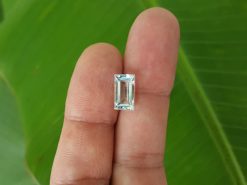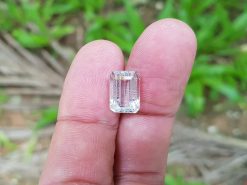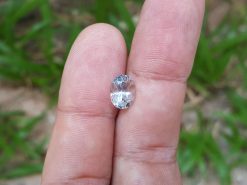Cat’s eye aquamarine

Cat’s eye aquamarine is a blue or cyan variety of beryl.
Buy natural aquamarine in our gem shop
It occurs at most localities which yield ordinary beryl. The gem-gravel placer deposits of Sri Lanka contain aquamarine. Chrysolite aquamarine is a green-yellow stone, occurring in Brazil. Maxixe is a deep blue version of aquamarine, commonly found in the country of Madagascar.
Its color fades to white under sunlight. It can also fade because of heat treatment. The color can returns with irradiation tratement. The pale blue color of aquamarine is attributed to Fe2+. Fe3+ ions produce golden-yellow color, and when both Fe2+ and Fe3+ are present.
The color is a darker blue as in maxixe. Decoloration of maxixe by light or heat thus may be due to the charge transfer between Fe3+ and Fe2+. Dark-blue maxixe color can be produced in green, also pink or yellow beryl by irradiating it with high-energy particles. Gamma rays, also neutrons or even X-rays.
Cat’s eye aquamarine effect
In gemology, chatoyancy, also chatoyance or cat’s eye effect, is an optical reflectance effect visible in certain gemstones. Coined from the French “oeil de chat”, meaning “cat’s eye”, chatoyancy arises either from the fibrous structure of a material, as in cat’s eye tourmaline, or from fibrous inclusions or cavities within the stone, as in cat’s eye chrysoberyl.
The precipitates that cause chatoyance are the needles. Examined samples have yielded no evidence of tubes or fibers.The needles precipitates all align perpendicularly with respect to cat’s eye effect. The lattice parameter of the needles matches only one of the three orthorhombic crystal axes of the chrysoberyl, as a result of an alignment along that direction.
The phenomenon resembles the brilliance of a silk spool. The luminous streak of reflected light is always perpendicular to the direction of the fibres. For a gemstone to show this effect better, the shape must be a cabochon. Round with a flat base, rather than faceted, with the fibers or fibrous structures parallel to the base of the finished gem.
The best finished specimens show a single sharply. A band of light that moves across the stone when it turns. Chatoyant stones of lesser quality display a banded effect as is typical with cat’s-eye varieties of quartz. Faceted stones do not show the effect well.
Cat’s eye aquamarine from India
Natural aquamarine for sale in our gem shop
We make custom made green aquamarine jewelry as engagement rings, necklaces, stud earrings, bracelets, pendants… Please contact us for a quote.
















